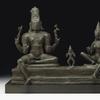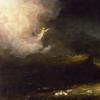Reframing Bierstadt's Mount Whitney
- CORNING, New York
- /
- September 30, 2013
An historic event took place at the Rockwell Museum of Western Art on Wednesday, September 25, 2013. Albert Bierstadt's iconic Mount Whitney was refitted with a custom-made replica of an 1870s American frame. Mount Whitney commands the Visions of the West Gallery at the Rockwell Museum as one of the nation's most important American landscape paintings.
After presenting a variety of frame options to the Rockwell Museum curatorial staff, the Manhattan-based firm of Gill & Lagodich Fine Period Frames & Restoration has spent the last 11 months researching and fabricating the custom-made 1870s gilded replica frame decorated with traditional American oak leaf-and-berry and neoclassical elements. The frame's individual nine rows of ornamentation, laid out from end to end, nearly measure the length of a football field and are covered with approximately 200 square feet of 23-karat gold leaf. The final step to bring the massive 500 lb frame from Manhattan to Corning will be no easy feat. Transported by truck, the 8 x 12 foot frame will be lifted three stories by crane into the Rockwell Museum. A team of six will remove the masterpiece painting from the wall to prepare for the new frame's installation.
In 2011, a conservator noticed inconsistencies in the current Mount Whitney frame. Areas of the molding along the bottom of the frame seemed muddy and unclear. The gold leaf was discolored in certain sections and had lost much of its original luster. Slowly, the story of the frame emerged. Long ago the painting was separated from its original frame. The current frame, as it turns out, is a reproduction of an 1850s French Empire-style frame, not an American frame from the 1870s. On closer examination, details in the current frame indicate that it had been expanded to accommodate Mount Whitney when the painting was purchased. The condition of the frame, especially the inserted sections, was deteriorating. This deterioration, which had become more noticeable in recent years, distracted from the beauty and power of Mount Whitney.
In consultation with a frame conservator, curatorial staff determined that commissioning a replica of an American period frame was the best course of action to properly preserve and present Mount Whitney.
This re-framing project reflects a wider effort within art museums to house their most important paintings in frames that are correct in style and time period. Most recently, curators have begun to look at frames more critically. The study of American frames in particular, is a relatively new field of scholarship, and it is only in the past few decades that collectors and museums are reevaluating the importance of frames on their own and in relation to paintings. After all, the way in which a work of art is mounted and framed has tremendous effect on its long-term preservation as well as the way the art is viewed.
"A frame is an important historical object and it is crucial to be appropriate to the painting it holds," says James Peck, Curator of Collections at the Rockwell Museum of Western Art.
"The Museum came to us seeking advice on the best solution for reframing Mount Whitney. We always to prefer to propose a period frame but to find something of the correct date and style in this immense size is a nearly impossible feat. Therefore we recommended a custom-made American replica frame," says Tracy Gill of Gill & Lagodich.
"Mount Whitney's current French frame, which we will restore and add to our gallery inventory, will likely someday find a home with a period-appropriate French painting," Gill adds.
The newly crafted one-of-a-kind frame will be similar to frames Bierstadt used in the nineteenth century. The frame is designed with an anthemion-pattern central molding and made with traditional materials and techniques - from woodwork to ornament casting to gilding and final patination. It was designed the way it would have been in the 1870s with its nine decorative patterns selected from appropriate period models and combined in the best way to enhance this particular painting. The ornament is all derived from 1870s frames in the over 2,000-piece period frame collection of Gill & Lagodich.
"Bierstadt was like a Spielberg of his time. Before high-tech entertainment, paintings like Mount Whitney were large entertainment. Bierstadt, and other painters of grand scenery like Frederic Church, would send their paintings on tour where patrons would pay to view these impressive panoramic paintings. Frames create a stage-like appearance for the art where the visitor can gaze in admiration," says Simeon Lagodich of Gill & Lagodich.
"A frame serves to preserve and enhance the artwork, but a frame and painting have a symbiotic relationship. With important historic paintings like this, it is paramount to have a frame of equal import," says Gill.
Gill & Lagodich is known for its expert staff, use of traditional materials, and museum-standard work. Applying nineteenth-century techniques, Mount Whitney's frame has been fabricated much as it would have been in the period. The framers chose seasoned, close-grained basswood, which is very stable and straight. The first step in creating a replica frame is to mill the wood, which will serve as a foundation for the ornament, gesso, bole (gilder's clay), and gold leaf. Twelve different custom-designed knives were used to mill the interlocking wood components for the frame's final molding profile. Nine different ornament patterns were cast in plaster and traditional composition (a mixture of chalk, linseed oil, rosin, and hide glue). After the ornament is placed on the wood, traditional layers of white gesso and gray and ochre bole (gilder's clay) are painted on and smoothed to prepare the layer for gilding. Burnishing the clay with an agate stone creates a polished substrate so the gold becomes mirror-like in selected areas and creates contrast between matte and bright ornament. Burnishing highlights certain details, such as the berries on the top edge and the large corner cartouches. The flat gilded frieze is also burnished and painstakingly hand-incised in an elegant running fret-and-flower pattern Finally, the frame is patinated with layers of pigments and toned shellacs, then hand-rubbed and distressed overall to make it look 150 years old.
"The objective is to recreate a frame of the highest quality that looks like it was made at the same time as the painting. Ultimately we want you to see the framed masterpiece as Bierstadt would have wanted. If we've created a frame that looks like the artist chose it, we've done our job right," says Gill.
This custom frame will reflect the spirit of the painting, not simply house it. Mount Whitney conveys the epic power of the Sierra Nevada mountain range with breathtaking bravado, transporting viewers into an Edenic Western wonderland. Displayed at the Paris Salon of 1880 and hailed as "one of the truly great landscapes of our country", Mount Whitney, c. 1877 has been an important part of the Rockwell Museum of Western Art and the Corning community for decades. Purchased by founding collector Bob Rockwell in the early 1960s, the massive painting had nowhere to hang when it arrived in Corning in 1965. In the spirit of community, Rockwell lent the masterpiece to the newly opened Houghton Library at Corning Community College where it hung, to great local fanfare, until 1969. During the 1970s, Mount Whitney was featured in exhibitions at the Corcoran Gallery, Washington D.C., the Denver Art Museum, and the Amon Carter Museum, Fort Worth, Texas.
The cost to build a new frame is significant. The Silver Dollar Society, a core group of Museum donors, designated their 2012 donation to support the reframing project as their gift to the Museum. Likewise, 100% of Museum staff contributed to this project. The Silver Dollar Society, staff and volunteer contribution is a collective statement of support for the best presentation of Mount Whitney, a keystone piece in the Museum collection.
Mount Whitney holds a place of honor to the Rockwell Museum of Western Art collection. Since the 1980s, Mount Whitney has served as the centerpiece of the Museum collection, and has become synonymous with the Rockwell Museum of Western Art. With the new frame, the luster and appeal of Mount Whitney will continue to serve as the cornerstone to the Rockwell collection.
About Gill & Lagodich Fine Period Frames & Restoration
Tracy Gill and Simeon Lagodich are co-owners of Gill & Lagodich Fine Period Frames & Restoration, New York City. They have each devoted more than twenty years to collecting, studying, restoring, selling and curating period frames. Their gallery has a current inventory of over two thousand period frames, American and European, which span over 400 years. They provide custom framing services and curatorial expertise to museums and private ¬collectors, architects, interior designers, and interested individuals. The Gill & Lagodich wood and gilding restoration studios produce the highest quality frame restoration and sizing services; custom-made frame replicas and custom fabrication of frames designed by artists, architects, and designers. As recognized as experts in their field, the Gill & Lagodich curriculum vitae includes reframing projects and consultation to nationally recognized art museums like the Art Institute of Chicago, Brooklyn Museum of Art, the Virginia Museum of Fine Arts, and the Metropolitan Museum of Art.
Gill & Lagodich Fine Period Frames & Restoration is the oldest existing antiques emporium in Manhattan's historic Tribeca neighborhood. Coincidentally, there was a frame maker/gilder, Lawrence Vanbuskirk, at the same address from years 1832-1835.www.gill-lagodich.com
















